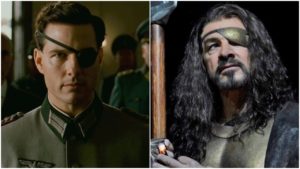
Opera Meets Film: How ‘Valkyrie’ Draws Parallels Between Wagner’s Ring & Plot to Kill Hitler
By David Salazar“Opera Meets Film” is a feature dedicated to exploring the way that opera has been employed in cinema. We will select a section or a film in its entirety, highlighting the impact that utilizing the operatic form or sections from an opera can alter our perception of a film that we are viewing. This week’s installment features Bryan Singer’s “Valkyrie.”
There is an inevitability to the fact that a film named “Valkyrie” will feature music from Wagner’s famous opera. And of course, it is to be expected that the piece showcased will be the most famous passage from the opera, the “Ride of the Valkyries.”
Claus von Stauffenberg (Tom Cruise) has just returned home from a grueling stay at the hospital. He is with his family once more and his children play a recording of the “Ride of the Valkyries” moments before an air raid attacks their own home. The music itself becomes an inciting incident with the filmmakers ending the sequence on a shot of the record playing the piece; the camera draws ever closer until we can read the title itself. From there the film cuts to a scene that launches the main plot of the film – the execution of “Operation Valkyrie.”
“Operation Valkyrie” was an emergency plan intended to deploy a reserve army that would act in the event of a national emergency; it ultimately ended in failure.
It must be noted that this film is based on real events and its characters themselves real beings. Yet, in the context of Wagner’s epic and its use in the film, it is impossible to not see the parallels between reality and fiction, some of the coincidences simply too perfect in how they lined up.
In fact, one might argue that “Operation Valkyrie” (and by extension the movie) is a retelling of Wagner’s Ring itself.
For example, Claus von Stauffenberg is the physical embodiment of Wotan himself. During a raid showcased at the start of the film, he loses his left eye, forced to wear an eye patch that is undeniably Wotan’s most famed physical trait. But Claus also lost his right hand and a ring on his left hand. This specific detail of him losing a ring is a subtle nod to Wotan’s own loss of his famed Ring in the tetralogy. Of course, Von Stauffenberg is based on a real-life character who suffered these very injuries, but the similarities are too great to ignore.
Then there’s the plan to murder Hitler, which brings the parallels between the two men even closer. In the Ring, Wotan wants to steal back the Ring from Fafner so that he can avoid destruction at the hands of the evil Alberich. He amasses an army of Valkyries to help him build up a stronger army that will help protect him from Alberich in the coming wars as the two men seek out the Ring. In the film, Von Stauffenberg is one of the drivers behind the attempted coup; like Wotan in the Ring Cycle when he happens upon the plan to recover the Ring and hence become the most powerful being, the film portrays Von Stauffenberg as the one to suggest “Operation Valkyrie” to the other men involved in the plot.
Von Stauffenberg’s plans are constantly foiled, much like Wotan’s own. His attempt to create a hero in Siegmund blows up in his face. And later in the saga, his power is completely minimized by Siegfried, the true hero who has won the Ring from Fafner. And at the end of it all, both men ultimately fail and this failure leads to their respective deaths. Von Stauffenberg is executed and one might argue the same fate for Wotan, who waits for the death of the Gods and eventually sees his order burned to the ground at the close of the four-part epic.
And then there is the portrayal of the two characters themselves. Both are shown as tragic heroes, seeking out power and control but coming short of obtaining it. The expressions of their respective motivations for this power grab are decidedly in their favor as both men are shown attempting to stop a dictatorial force who is incapable of love (Hitler and Alberich).
But both are far from morally righteous. Historically, Von Stauffenberg was never an official member of the Nazi party, but he did share many controversial and racist comments and spoke in favor of Hitler during the 1932 presidential election. He also supported the invasion of Poland and the use of the Poles as slave workers. His views would shift, but his actions left their mark nonetheless.
Meanwhile, Wotan is the keeper of laws but he is unfaithful and constantly looks to cheat out others and gain control over them; he builds a massive castle in the sky to keep greater control over his family members.
Nonetheless, both works of art portray these characters with varying sympathy, adding to their complexity.


